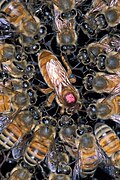Top Qs
Timeline
Chat
Perspective
Animal identification
Process done to identify and track animals From Wikipedia, the free encyclopedia
Remove ads
Animal identification using external marks or internal identifiers is a process done to identify and track specific animals. It is done for a variety of reasons including verification of ownership, biosecurity control, and tracking for research or agricultural purposes.

History
Individual identification of animals by means of body markings has been practiced for over 3,800 years, as stated in Code of Hammurabi.[1] The first official identification systems are documented as far as the 18th century. In Uruguay for instance maintained at that time a register of hot brands.[2]
Noninvasive methods
Summarize
Perspective
Wildlife photo-identification

Photo-identification is a technique used to identify and track individuals of a wild animal study population over time. It relies on capturing photographs of distinctive characteristics such as skin or pelage patterns or scars from the animal. In cetaceans, the dorsal fin area and tail flukes are commonly used.
Photo-identification is generally used as an alternative to other, invasive methods of tagging that require attaching a device to each individual. The technique enables precise counting, rather than rough estimation, of the number of animals in a population. It also allows researchers to perform longitudinal studies of individuals over many years, yielding data about the lifecycle, lifespan, migration patterns, and social relationships of the animals.
Species that are studied using photo-identification techniques include:
Biometrics
Rather than tags or tattoos, biometric techniques may be used to identify individual animals: zebra stripes, blood vessel patterns in rodent ears, muzzle prints, bat wing patterns, primate facial recognition and koala spots have all been tried.[8]
Remove ads
Birds
- Leg rings
- Wing tags
- Microchip implants (parrots)
- Telemetry (falconry birds)
Domesticated mammals
Sheep
- Freeze branding
- Branding (hot-iron)
- Collar
- Earmarking
- Ear tags (non-electronic)
- Ear tags (electronic)
- Semi-permanent paint
Pigs
- Collars (electronic and non-electronic)
- Earmarking
- Ear tags (non-electronic)
- Ear tags (electronic)
- Semi-permanent paint
- Tattoo (see animal tattoo)
Horses
- Collars (non-electronic)
- Branding (hot-iron)
- Branding (freeze)
- Microchip implants
- Lip tattoo
Cattle
Dogs
- Collar
- Microchip implants
- Tattoo
Laboratory rodents
- Earmarking (notching or punching)
- Ear tags (nickel, copper or scannable 2D barcode tags)
- Microchip implants
- Hair dye
- Toe clipping[note 1]
- Manual tattoos (tail, foot pad or ears)
- Automated tail tattoos[10]
Remove ads
Wild mammals
Bats
- Photo-identification of wing membranes[11]
Koalas
- Photo-identification of noses[12]
Giraffes
- Photo-identification[13]
Zebras
- Photo-identification of stripes[9]
Marine mammals
Fish
- Microchip implants
- Fin clipping
- Coded wire tag
- Passive integrated transponder
- Acoustic tag
- Visible implant elastomer (VIE)
Sharks
- Photo-identification[19]
Amphibians
- Microchip implants
- Toe clippings
- Passive integrated transponder
- Visible implant elastomer (VIE)[20]
- Photo-identification[20]
Invertebrates
- Adhesive tags
- Semi-permanent paint
- Photo-identification[10]
National animal identification schemes
- British Cattle Movement Service in Britain
- National Animal Identification and Tracing in New Zealand
- National Animal Identification System in the United States
- National Livestock Identification System in Australia
Footnotes
- 'Toe clipping' in mice involves the full or partial amputation of one or more digits as a means of permanent identification.
Gallery
- Great frigatebird with a wing tag
- Bird ring
- Sheep with an earmark
- Pig with earmark
- Horse with a brand
- Santa Gertudis cattle with electronic and non-electronic ear tags
- Calf with a non-electronic ear tag, numbered collar and transponder (blue device)
- Bear with an ear tag and transponder
- Tattoo inside a Greyhound's ear
- Dog collar with dog license and other dog tags
- A microchip implant and applicator
- A laboratory mouse with an ear tag
- Fish with a transponder
- Harbour seal with a transponder
- Common seal with an adhesive tag
- European queen honey bee marked with a paint spot surrounded by Africanised honeybees
- Sheep with painted number
- Monarch butterfly tagged with a sticker
- Mussels being tagged
References
Wikiwand - on
Seamless Wikipedia browsing. On steroids.
Remove ads


















